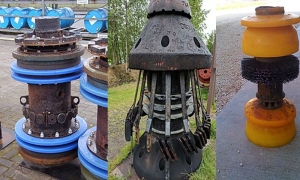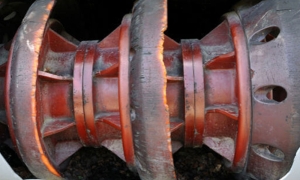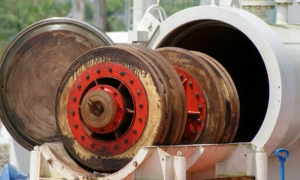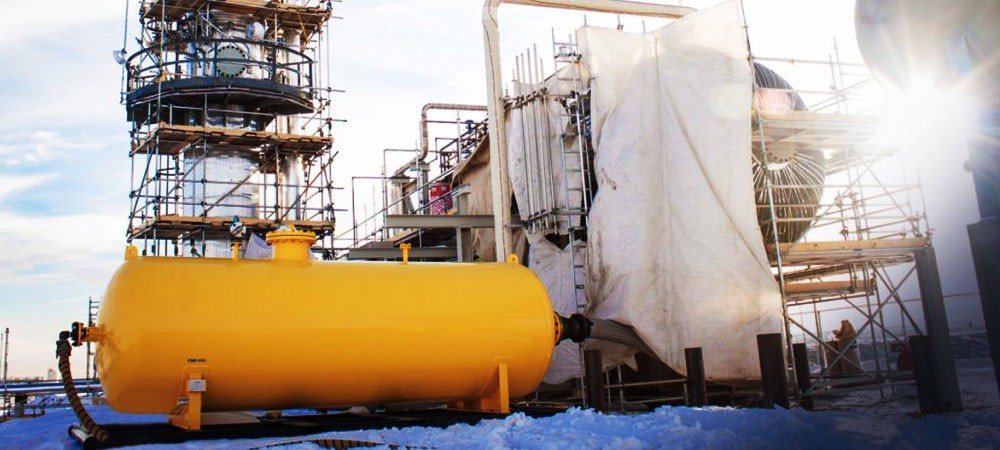Pigging Services
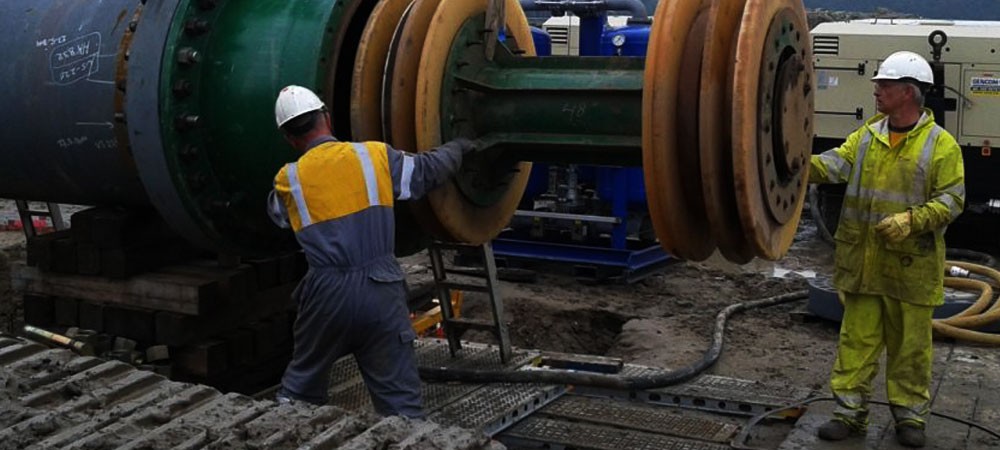
Pigging Services
Pigging is an in-line inspection (ILI) technique in which devices referred to as pigs are inserted into pipelines to perform cleaning and inspection activities. Pigging can be conducted on a variety of pipeline sizes without having to stop the flow of material through the line.
A pig is placed into the pipeline at a valve or pump station that has a special configuration of valves and pipes where the tool can be loaded into a receiver. Once the receiver is closed and sealed, the pig is then driven down the line, either being pulled through by a cable or being pushed through by the flow of the product.
Traditionally, pigging was used purely to clean pipelines. The pig was simply placed at one end of a pipeline and pushed through the line by the product flow. It scrapes the sides of the pipe as it travels, removing dirt and debris as it goes.
Pigs can be fitted with various non-destructive technologies that can scan the pipe through which it travels. These are often referred to as "smart pigs." There are several different types of smart pigs utilized in ILI activities, each with its own set of advantages and disadvantages. Some are more effective at detecting certain types of corrosion or damage in different types of pipes, depending on their NDE capabilities. More recently though, some manufacturers are combining the various functions of these separate tools into one. This way a single tool can now be used to detect several different types of damage, making it more efficient and effective.
Intelligent Pigging is an inspection technique whereby an inspection probe, often referred to as a "smart" pig, is propelled through a pipeline while gathering important data, such as the presence and location of corrosion or other irregularities on the inner walls of the pipe.
What makes intelligent pigging different is that smart pigs can perform advanced inspection activities as they travel along the pipe, in addition to just cleaning it. Smart pigs use non-destructive examination techniques such as ultrasonic testing and magnetic flux leakage testing to inspect for erosion corrosion, metal loss, pitting, weld anomalies, and hydrogen-induced cracking, among others. They are also able to gather data on the pipeline's diameter, curvature, bends, and temperature.
Smart pigging provides several advantages over traditional forms of pipeline inspection. It allows pipelines to be cleaned and inspected without having to stop the flow of the product. It also allows a pipeline to be completely inspected without having to send inspectors down its entire length. Finally, it provides cleaning and inspection services at the same time, saving companies both time and money.
PIGGING SERVICES
The gradual buildup of debris, grease, corrosion, and fractures within gas pipelines is a serious problem that affects flow integrity and can result in accidents. A special tool, known as a pipeline pig, can help prevent these problems to ensure optimal flow assurance.
This article will outline the pipeline pigging procedure, types of gas line pigs, and common applications.
Pipeline pigs, a backronym for pipeline intervention gadgets are devices used to clean or inspect pipelines in upstream, midstream, and downstream O&G operations. Interestingly, the name may have originated from the squealing sound early pig models (made of straw and wire or leather) produced while traveling through pipelines.
Pigging in Oil and Gas Pipelines
Pigging in the oil and gas industry is a form of flow assurance where pipeline pigs are used to purge, clean, and/or inspect pipelines to keep them running smoothly. Since the operation is hazardous, pigging must only be carried out by experienced professionals.
Purpose of Pipeline Pigging
The following are some justifications for pigging gas pipelines:
- Keeps pipelines clean and free of obstruction
- Ensures optimal flow integrity of pipelines
- Can be used to inspect internal sections of pipelines to plan for remedial operations
The typical pigging system consists of a pig, a launcher, and a receiver, collectively known as the pig trap. The pig is a cylindrical device that travels the length of a pipeline by being pulled by a string or using the force of a fluid flowing through the line.
The pig launcher releases the pig from one end of the pipeline (launcher station) and the receiver retrieves it at the other end (receiver station). Pipeline pigging is a potentially hazardous procedure that must be carried out by competent professionals.
Pipeline Pig Types
For the most effective results, it is essential to select the appropriate pipeline pig for the job. The following are some common pipeline pig types used in the oil and gas industry today:
Utility Pigs
Utility pigs are used for cleaning, dewatering, and sealing of gas pipelines. To flush a gas line, a utility pig sweeps through the internal section, scraping off debris and semi-solids that obstruct or limit the flow of hydrocarbons.
When used for dewatering or sealing, the pig provides air and moisture-tight coupling to flush liquids from the line or separate different in-line media.
- Mandrel Pigs Consist of a steel mandrel body with a series of replaceable cups and discs (sealing elements). Mandrel pigs contain special brushes that remove debris from the internal sections of pipelines. A key benefit of this type of pig is its cost-effectiveness worn-out components can be replaced resulting in a brand-new pig.
- Solid Cast Pigs Consist of a single piece of polyurethane polymer or steel.
- Foam Pigs Consist of a combination of polymer foam embedded with solid abrasive materials.
- Spherical Pigs Consist of hollow, spherical balls made from polyurethane or neoprene. Spherical pigs are mostly inflatable and filled with liquids such as glycol or water to retain their shape when exposed to the high pressures within gas pipelines.
Gel Pigs
Gel pigs consist of chemical substances such as rigid polymers and high-viscosity gels. They are typically used during pipeline commissioning or maintenance. They are the ideal option for so-called unsingable lines pipelines containing internal valves, sharp bends, and/or special structures that could result in a stuck pig.
Unlike other pig types, gel pigs do not require a launcher and receiver system. Gel pigs are often used alongside other types of pigs to improve efficiency and prevent the deterioration of the primary pig components. They can also help to retrieve a pig stuck in a pipeline.
Inspection Pigs
Inspection pigs also called smart pigs, are used for inspecting internal sections of gas pipelines ahead of remedial activities. They contain electronic components such as ultrasonic sensors, RF modules, and pig gauge plates, and can measure parameters such as diameter, curvature, thickness, pressure, metal loss, and temperature. Newer inspection pigs can detect issues in pipelines such as leaks, cracks, wax deposition, and corrosion with a high degree of accuracy.
Specialty Pigs
These types of pigs, also called plugs are used to seal off entire sections of pipelines while remedial activities are being carried out. Specialty pigs are used by pipeline maintenance service companies for pipeline cleaning without completely restricting the flow of fluids through them.
PIGGING SERVICES
Pigging is used to clean large-diameter pipelines in the oil industry. Today, however, the use of smaller diameter pigging systems is now increasing in many continuous and batch process plants as plant operators search for increased efficiencies and reduced costs.
Pigging can be used for almost any section of the transfer process between, for example, blending, storage, or filling systems. Pigging systems are installed in industries handling products as diverse as lubricating oils, paints, chemicals, toiletries, cosmetics, and foodstuffs.
Pigs are used in lube oil or paint blending to clean the pipes to avoid cross-contamination and to empty the pipes into the product tanks (or sometimes to send a component back to its tank). Usually, pigging is done at the beginning and at the end of each batch, but sometimes it is done during a batch, such as when producing a premix that will be used as an intermediate component.
Pigs are also used in oil and gas industries to clean or clear pipelines. Intelligent or "Smart pigs" are used to inspect pipelines to assess their condition and to prevent leaks, which can be hazardous or harmful to the environment. They usually do not interrupt production, though some products can be lost when the pig is removed. They can also be used to separate different products in a multiproduct pipeline and to clear slugs of liquid from multiphase gas/liquid pipelines.
Pigging requires the pipeline to be designed to be pigged from the outset. If the pipeline contains topological variations including changes in diameter, butterfly valves, instrumentation, tight bends, pumps, or reduced port ball valves, the pipeline cannot be traditionally pigged. In such instances, alternatives such as Ice Pigging may be employed. Full port (or full bore) ball valves cause no problems because the inside diameter of the ball opening is the same as that of the pipe.
A major advantage of multi-product pipelines of pluggable systems is the potential for product savings. At the end of each product transfer, it is possible to segregate the next products using a pigging sphere. Alternatively, it is possible to clear out the entire line contents with the pig, either forward to the receipt point, or backward to the source tank. There is no requirement for extensive line flushing.
Without the need for line flushing, pigging offers the additional advantage of a much more rapid and reliable product changeover. Product sampling at the receipt point is faster with pigs because the interface between products is very clear; the old method of checking at intervals to determine where the product is on specification takes considerably longer.
Pigging can also be operated totally by a programmable logic controller (PLC).
Pigging systems are designed so that the pig is loaded into the launcher, which is pressured to launch the pig into the pipeline through a kicker line. In some cases, the pig is removed from the pipeline via the receiver at the end of each run. All systems must allow for the receipt of pigs at the launcher, as blockages in the pipeline may require the pigs to be pushed back to the launcher. Many systems are designed to pig the pipeline in either direction.
The pig is pushed either with a gas or a liquid; if pushed by gas, some systems ] can be adapted in the gas inlet in order to ensure the pig's constant speed, whatever the flow pressure is. The pigs must be removed, as many pigs are rented, pigs wear and must be replaced, and cleaning (and other) pigs push contaminants from the pipeline such as wax, foreign objects, hydrates, etc., which must be removed from the pipeline. There are inherent risks in opening the barrel to atmospheric pressure so care must be taken to ensure that the barrel is depressurized prior to opening. If the barrel is not completely depressurized, the pig can be ejected from the barrel and operators have been severely injured when standing in front of an open pig door. A pig was once accidentally shot out of the end of a pipeline without a proper pig receiver and went through the side of a house 150 meters (500 ft) away. When the product is sour, the barrel should be evacuated to a flare system where the sour gas is burnt. Operators should wear a self-contained breathing apparatus nbsp; when working on sour systems.
A few pigging systems utilize a "captive pig", and the pipeline is only opened occasionally to check the condition of the pig. At all other times, the pig is shuttled up and down the pipeline at the end of each transfer, and the pipeline is never opened up during process operation. These systems are not common.
